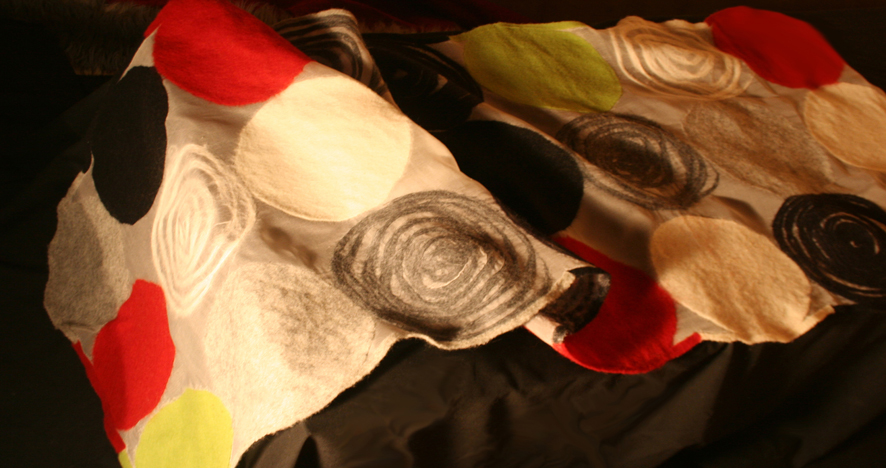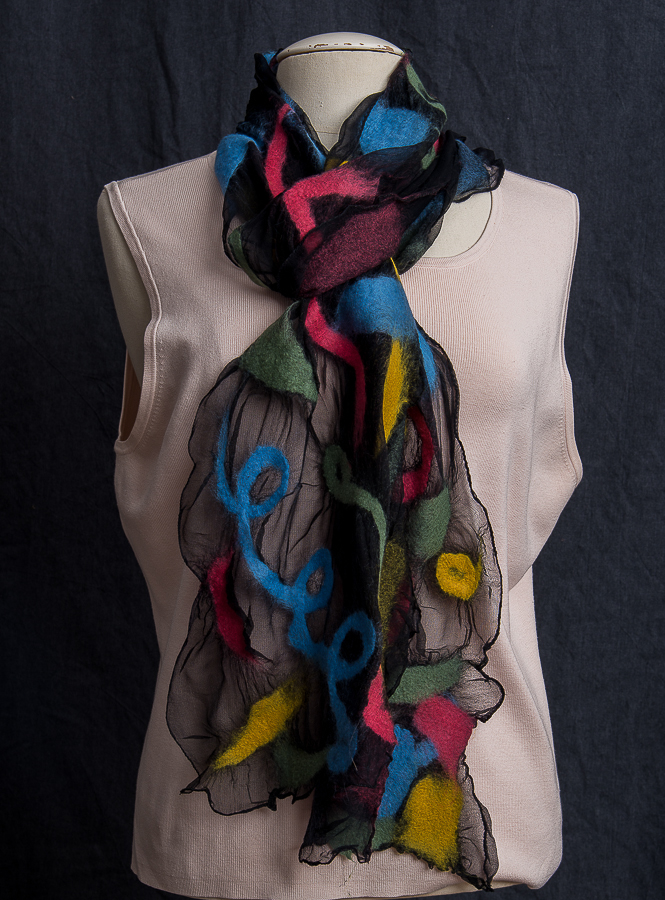Nuno felting on:
[Wikipedia]
[Google]
[Amazon]

 Nuno felting is a fabric
Nuno felting is a fabric
 Nuno felting creates a highly versatile fabric. It can be made in many weights to accommodate many different uses. It can be made much lighter in weight than traditional all-wool felt, accounting for its movement and drape. Because of the range of weights possible with the cloth very diverse garments can be made.
A lightweight Nuno fabric is made by laying one layer of loose fiber onto an open weave fabric base, creating a lightweight material. A much heavier Nuno fabric results from applying 3-4 layers of loose fibers onto an open weave base creating fabric ideal for a winter coat. A pair of boots could be made using even more layers of fibers.
Nuno felting creates a highly versatile fabric. It can be made in many weights to accommodate many different uses. It can be made much lighter in weight than traditional all-wool felt, accounting for its movement and drape. Because of the range of weights possible with the cloth very diverse garments can be made.
A lightweight Nuno fabric is made by laying one layer of loose fiber onto an open weave fabric base, creating a lightweight material. A much heavier Nuno fabric results from applying 3-4 layers of loose fibers onto an open weave base creating fabric ideal for a winter coat. A pair of boots could be made using even more layers of fibers.




 Nuno felting is a fabric
Nuno felting is a fabric felt
Felt is a textile material that is produced by matting, condensing and pressing fibers together. Felt can be made of natural fibers such as wool or animal fur, or from synthetic fibers such as petroleum-based acrylic or acrylonitrile or wood ...
ing technique developed by Polly Stirling, a fiber artist from New South Wales, Australia
)
, nickname =
, image_map = New South Wales in Australia.svg
, map_caption = Location of New South Wales in AustraliaCoordinates:
, subdivision_type = Country
, subdivision_name = Australia
, established_title = Before federation
, es ...
, around 1992. The name is derived from the Japanese word, "Nuno," meaning cloth.Ziek, B. (2004). The felt frontier: I: Polly Stirling: Contemporary feltmaker. Surface Design Journal, 28(4), 35-38
Techniques
This technique bonds loose fiber (usually sheep'swool
Wool is the textile fibre obtained from sheep and other mammals, especially goats, rabbits, and camelids. The term may also refer to inorganic materials, such as mineral wool and glass wool, that have properties similar to animal wool. ...
) into a sheer fabric, such as silk
Silk is a natural protein fiber, some forms of which can be woven into textiles. The protein fiber of silk is composed mainly of fibroin and is produced by certain insect larvae to form cocoons. The best-known silk is obtained from th ...
gauze, creating a lightweight felt. Other fibers are also used to create different surface textures. Other fibers used include wool from camel
A camel (from: la, camelus and grc-gre, κάμηλος (''kamēlos'') from Hebrew or Phoenician: גָמָל ''gāmāl''.) is an even-toed ungulate in the genus ''Camelus'' that bears distinctive fatty deposits known as "humps" on its back. ...
, llama
The llama (; ) (''Lama glama'') is a domesticated South American camelid, widely used as a meat and pack animal by Andean cultures since the Pre-Columbian era.
Llamas are social animals and live with others as a herd. Their wool is soft ...
, alpaca
The alpaca (''Lama pacos'') is a species of South American camelid mammal. It is similar to, and often confused with, the llama. However, alpacas are often noticeably smaller than llamas. The two animals are closely related and can success ...
, Mohair goat, Cashmere goat, yak
The domestic yak (''Bos grunniens''), also known as the Tartary ox, grunting ox or hairy cattle, is a species of long-haired domesticated cattle found throughout the Himalayan region of the Indian subcontinent, the Tibetan Plateau, Kachin S ...
, and rabbit
Rabbits, also known as bunnies or bunny rabbits, are small mammals in the family Leporidae (which also contains the hares) of the order Lagomorpha (which also contains the pikas). ''Oryctolagus cuniculus'' includes the European rabbit sp ...
fur.
Those fibers can completely cover the background fabric, or they may be used as a decorative design that allows the backing fabric to show. Nuno felting often combines several layers of loose fibers to build up the finished fabric's color, texture, and design elements.
The Nuno felting process is particularly suitable for creating lightweight fabrics used to make clothing. The use of silk or other stable fabric in the felt creates a fabric that will not stretch out of shape. Fabrics such as nylon
Nylon is a generic designation for a family of synthetic polymers composed of polyamides ( repeating units linked by amide links).The polyamides may be aliphatic or semi-aromatic.
Nylon is a silk-like thermoplastic, generally made from pet ...
, muslin
Muslin () is a cotton fabric of plain weave. It is made in a wide range of weights from delicate sheers to coarse sheeting. It gets its name from the city of Mosul, Iraq, where it was first manufactured.
Muslin of uncommonly delicate hands ...
, or other open weaves can be used as the felting background, which results in varying textures and colors.
 Nuno felting creates a highly versatile fabric. It can be made in many weights to accommodate many different uses. It can be made much lighter in weight than traditional all-wool felt, accounting for its movement and drape. Because of the range of weights possible with the cloth very diverse garments can be made.
A lightweight Nuno fabric is made by laying one layer of loose fiber onto an open weave fabric base, creating a lightweight material. A much heavier Nuno fabric results from applying 3-4 layers of loose fibers onto an open weave base creating fabric ideal for a winter coat. A pair of boots could be made using even more layers of fibers.
Nuno felting creates a highly versatile fabric. It can be made in many weights to accommodate many different uses. It can be made much lighter in weight than traditional all-wool felt, accounting for its movement and drape. Because of the range of weights possible with the cloth very diverse garments can be made.
A lightweight Nuno fabric is made by laying one layer of loose fiber onto an open weave fabric base, creating a lightweight material. A much heavier Nuno fabric results from applying 3-4 layers of loose fibers onto an open weave base creating fabric ideal for a winter coat. A pair of boots could be made using even more layers of fibers.



References